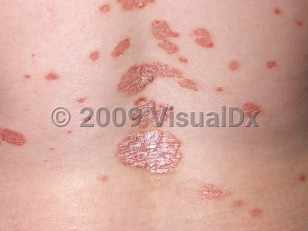Psoriasis - Anogenital in
See also in: Overview,Hair and Scalp,Nail and Distal DigitAlerts and Notices
Important News & Links
Synopsis

There are many differing clinical patterns of psoriasis, including plaque type, guttate psoriasis (which often follows strep throat), palmar-plantar psoriasis, erythrodermic psoriasis, and pustular psoriasis. Involvement of the inguinal areas and axillae is termed inverse psoriasis.
Psoriasis can involve the nails (up to one-third of 313 children in one study) and may also be limited to the fingernails or to body areas such as the genitals, scalp, feet, or even a solitary fingertip. Psoriasis can often be seen in the diaper area and in the skin folds of very young children.
Anogenital psoriasis is rather common and usually is comparable to psoriasis found elsewhere on the body. It can be isolated to the genitalia but often is part of a more generalized affliction. In males, inverse psoriasis is found on the scrotum, perirectal skin, and inguinal folds. Penile psoriasis is found on the glans and under the foreskin.
Codes
L40.0 – Psoriasis vulgaris
SNOMEDCT:
9014002 – Psoriasis
Look For
Subscription Required
Diagnostic Pearls
Subscription Required
Differential Diagnosis & Pitfalls

Subscription Required
Best Tests
Subscription Required
Management Pearls
Subscription Required
Therapy
Subscription Required
Drug Reaction Data
Subscription Required
References
Subscription Required
Last Updated:08/08/2022
 Patient Information for Psoriasis - Anogenital in
Patient Information for Psoriasis - Anogenital in - Improve treatment compliance
- Reduce after-hours questions
- Increase patient engagement and satisfaction
- Written in clear, easy-to-understand language. No confusing jargon.
- Available in English and Spanish
- Print out or email directly to your patient



